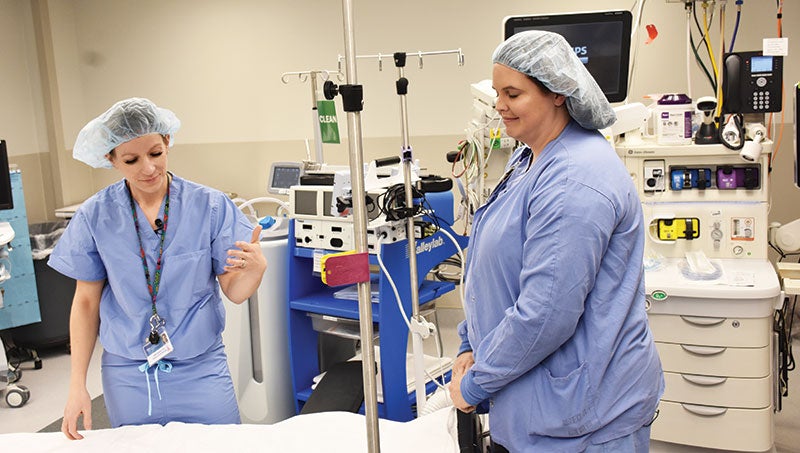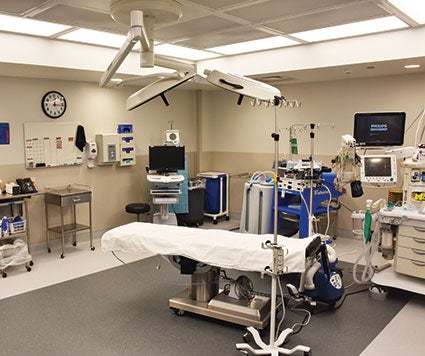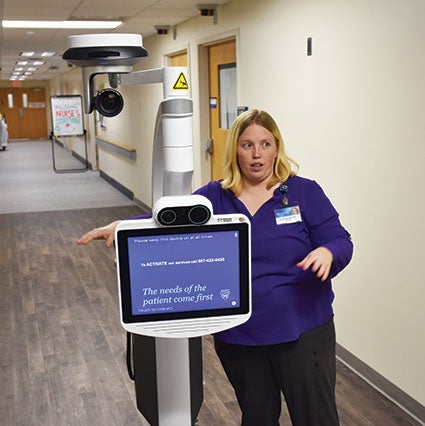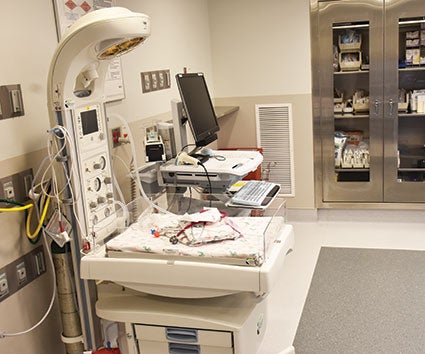Austin’s Mayo Clinic showcases new C-Section facility
Published 6:45 am Tuesday, December 3, 2019

- Dr. Heidi Gaston, who is in charge of OBGYN services at Mayo Clinic Health System–Austin, left, and Dr. Jennifer Gloin, Chair of the anesthesiology department, in the new caesarian section suite at the hospital. Tyler Jensen/tyler.jensen@austindailyherald.com.
As part of ongoing renovations at Mayo Clinic Health System–Austin, a new caesarian section operating room is opening this morning.
The new room is larger than the older one, allowing two children to be kept there after their mother has the procedure.
This means doctors and nurses can care for twins in the same room, said Dr. Heidi Gaston, Chair of OBGYN services at Austin.
“We have designed this unit so we can function and really emphasize the care for each of those patients rather than having to compromise or consider compromising care for one or the other,” she said.
Having the operating area for the mother across the room from where the newborns are being taken care of makes procedures run smoother and more efficiently, said Dr. Jennifer Goins, Chair of the anesthesiology department.

The new caesarian section suite at Mayo Clinic Health System–Austin is larger than before, allowing staff more room to maneuver when caring for new mothers and their children.
“Having separated space allowing us to focus on this baby and not worrying about contaminating an operating field and putting mom at any additional risk is a huge improvement,” she said.
While staff was capable of caring for parent and child in the same room previously, Goins said it required more care to avoid contaminating sterile equipment.
The room is only used for patients undergoing c-sections and is stocked with equipment before procedures begin. When the crews enter the room for work, they only have to verify everything is in place, Goins said.
“When you’re worrying about life and death, you don’t want to have to worry about whether your equipment is ready for you,” she said.
One piece of equipment in the room is a setup that allows the doctors to connect with a neonatologist in Rochester, said Dr. Sarah Scherger, chair of pediatrics in Austin.
The neonatologist can see all the information on a patient, view them through a camera and direct the onsite medical practitioners in the event a procedure is needed, she said.
The neonatologist is called if the baby is born in distress or is born pre-term.
“It’s phenomenal,” Scherger said.

Dr. Sarah Scherger, Chair of pediatrics at Mayo Clinic Health System–Austin, with a machine that allows medical staff to connect with a neonatologist in Rochester to care for newborn children with medical issues. The neonatologist views the patient and information through cameras and advises the medical team on care.
The new room setup allows doctors and nurses to use the equipment easier, she said.
Another improvement to the facilities are the changing room for the medical professionals who have to suit up in scrubs, hairnets and foot covers before entering the sterile operating room.
The unisex closet doctors and nurses originally changed in has been replaced with two locker rooms, each containing a shower for cleaning off fluids from procedures, Gaston said.
When staff enter the new unit, there is a scrub sink right there, which was not in the old facility.
This is aimed at reducing risks of infection by having employees scrub themselves at the beginning of a shift to remove the bacteria people normally pick up, Gaston said.
The whole setup creates a very linear flow for workers, Goins said.
“It’s just a little more fluid than what we had before,” she said.
Operating crews working downstairs previously changed in their locker rooms before coming upstairs if they were doing a procedure in the OBGYN area, Goins said.
“It just makes us a little faster,” she said.
For Goins, having standardized procedures and equipment makes procedures safer and more efficient.
While having a child can be a very joyous time, it can also be stressful, Gaston said. Giving moms the best experience possible is something that is beneficial for the patient’s health, she said.

After a baby is born in the c-section suite, they can either be given to their mother or taken to an area in the room where doctors can care for them while they are kept in an infant warmer.
Combining Albert Lea and Austin deliveries
Not only is the facility being updated, but how deliveries in the area are being conducted is also changing.
From now on, deliveries will be done at the Austin campus rather than at both it and the hospital in Albert Lea.
Gaston said the thought behind the decision was that practice makes perfect.
“The more you do something, the more efficient you are and the more safe you are in doing that thing,” she said.
Having staff handle increased amounts of deliveries makes them better at the procedure and allows the formerly two groups to bring the best practices from each together.
“We’re getting the best quality of care each site has provided previously and improving both as they merge,” Gaston said.
Bringing the two sites together also allows staff from different disciplines to work together on a daily basis to plan how to deal with the patient, Gloin said.
Combining the sites also means having a dedicated anesthesiologist during the day for obstetrics and in the event of a situation in the emergency room. This is in addition to the anesthesiologists normally on call, Gloin said.
Clinical services like gynecology, pediatric and more, will still be at the Albert Lea facility.
Once the project is complete, there will be 10 labor and recovery suites in addition to the c-section area.

